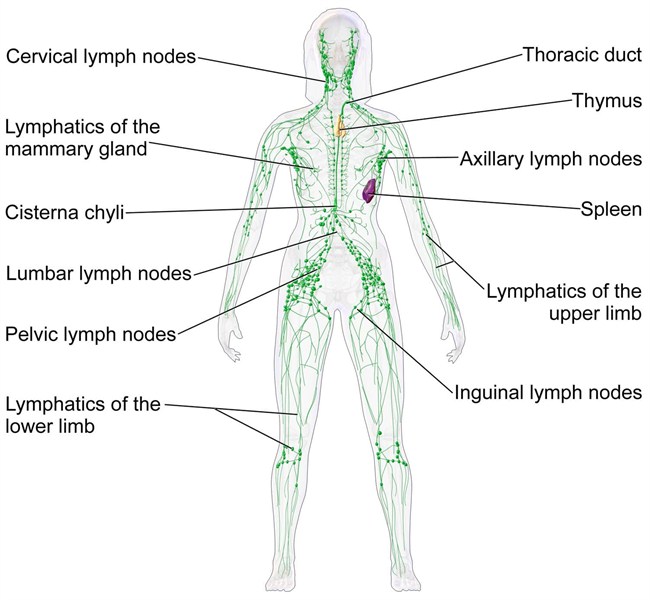Lymphadenectomy
A lymphadenectomy, also known as lymph node dissection, is a surgical procedure to remove one or more lymph nodes or groups of lymph nodes, which are then evaluated for the presence of cancer. It is important to know whether cancer has spread to the lymph nodes. After the lymph nodes are removed a sample of tissue is checked under a microscope for signs of cancer. For a regional lymphadenectomy, some of the lymph nodes in the tumor area are removed; for a radical lymphadenectomy, most or all of the lymph nodes in the tumor area are removed. Also called lymph node dissection.
What are Lymph Nodes
The lymphatic system is responsible for returning excess fluid from body tissues to the circulatory system and for defending against foreign or harmful agents such as bacteria, viruses, or cancerous cells. The major components of the lymphatic system are lymph capillaries, lymph vessels, and lymph nodes. Lymph is a clear fluid found in tissues that originates from the circulatory system. Lymph capillaries are tiny vessels that carry excess lymph to larger lymph vessels; these in turn empty to the circulatory system. Lymph nodes are small, oval- or bean-shaped masses found throughout the lymphatic system that act as filters against foreign materials. They tend to group in clusters in such areas as the neck (cervical lymph nodes), under the arm (axillary lymph nodes), the pelvis (iliac lymph nodes), and the groin (inguinal lymph nodes).

Diagram of Female Lymphatic System
Blausen.com staff. "Blausen gallery 2014". Wikiversity
Why It's Done
The lymphatic system plays an important role in the spread of cancerous cells to distant organs in the body. Cancer cells may break away from the primary tumor site and travel through the bloodstream or lymphatic system to other sites in body. This is especially true of breast cancer, melanoma, head and neck cancer, differentiated thyroid cancer, as well as lung, gastric and colorectal cancer. Cancer cells from these tumors may then begin growing at distant sites or in the lymph nodes themselves, a process known as metastasis. Removal of the lymph nodes enables doctors to determine if a cancer has begun to metastasize. A lymphadenectomy may also prevent further spread of abnormal cells.
Patients with a positive or "involved" sentinel lymph node are likely have cancer in other lymph nodes indicating the need for more aggressive treatment such as a selective or complete lymphadenectomy. In this procedure, also known as a "formal lymph node dissection", some or all of the regional lymph nodes are removed and evaluated for cancer, the intent being to prevent further metastasis of the melanoma, regionally or to distant organs.
Sentinel Lymph Node Biopsy
Sentinel lymph node biopsy is the removal of the sentinel lymph node during surgery. The sentinel lymph node is the first lymph node to receive lymphatic drainage from a tumor. It is the first lymph node where the cancer is likely to spread. A radioactive substance and/or blue dye is injected near the tumor. The substance or dye flows through the lymph ducts to the lymph nodes. The first lymph node to receive the substance or dye is removed. A pathologist views the tissue under a microscope to look for cancer cells.
Breast Cancer
Lymph node mapping and sentinel lymph node biopsy are done to check for cancer in the sentinel lymph node (the first lymph node the cancer is likely to spread to from the tumor) during surgery. In sentinel lymph node biopsy, a radioactive substance and/or blue dye is injected near the tumor. The substance or dye flows through the lymph ducts to the lymph nodes. The first lymph node to receive the substance or dye is removed. A pathologist views the tissue under a microscope to look for cancer cells. If cancer cells are found, more lymph nodes will be removed and tissue samples will be checked for signs of cancer. This is called a lymphadenectomy.
After the sentinel lymph node biopsy, the surgeon removes the tumor using breast-conserving surgery or mastectomy. If cancer cells were not found in the sentinel lymph node, it may not be necessary to remove more lymph nodes. If cancer cells were found, more lymph nodes will be removed through a separate incision. This is called a lymph node dissection.
Axillary Lymph Node Biopsy
Breast cancer cells are most likely to spread first to lymph nodes located in the axilla, or armpit area, next to the affected breast. However, in breast cancers close to the center of the chest (near the breastbone), cancer cells may spread first to lymph nodes inside the chest (under the breastbone) before they can be detected in the axilla.
The number of lymph nodes in the axilla varies from person to person but usually ranges from 20 to 40. Historically, removal of these lymph nodes (in an operation called axillary lymph node dissection, or ALND) was done for two reasons: to help stage breast cancer and to help prevent a regional recurrence of the disease. (Regional recurrence of breast cancer occurs when breast cancer cells that have migrated to nearby lymph nodes give rise to a new tumor.)
Because removing multiple lymph nodes at the same time has been associated with adverse effects, the possibility that SLNB alone might be sufficient for staging breast cancer in women who have no clinical signs of axillary lymph node metastasis, such as swollen or “matted” (clumped or stuck together) nodes, was investigated.
Melanoma
Patients being evaluated for advanced melanoma will first undergo a sentinel lymph node biopsy near the site of the tumor. The sentinel node is the first lymph node that cancer cells encounter as they travel along the lymphatic vessels.
The draining sentinel node is identified by the surgeon through a procedure known as "sentinel lymph node mapping". The node is then excised (removed) and evaluated by a pathologist for the presence of cancer. If the sentinel node is free of cancer, this is highly predictive of freedom from metastasis in the nearby regional lymph nodes.
About the Procedure
A lymphadenectomy is usually performed under general anesthesia . An incision is made in the skin above the area of the affected lymph nodes. The lymph nodes, nearby lymphatic tissue and some underlying soft tissue are then removed and evaluated (dissected). Complications of the procedure include:
- Lymphedema, swelling of a limb affected by removal of lymph nodes
- Numbness, tingling, or pain in area of surgery
- Sloughing (breakdown) of skin in the area of surgery




